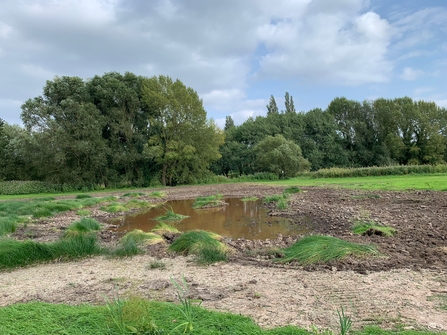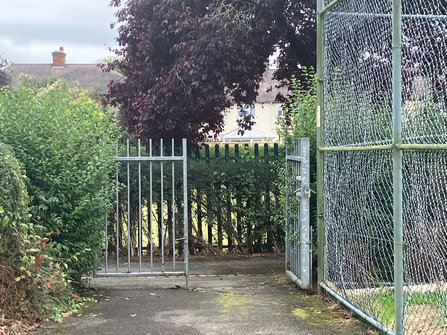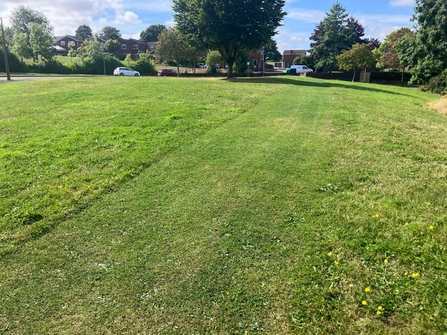August has seen the completion of our pond installations across the areas in this phase of conservation. When we last updated you, ponds at The Meadows in Queensville were underway, and we were preparing the land at Rising Brook and Kingsmead Marsh Local Nature Reserve, cutting grass and conducting bird surveys.
Stafford Brooks Project Update: It's time to set seed
The Meadows, Queensville:
While the ponds at Queensville have been dug, and the spoil laid out ready to receive seed, the donor fields which contain our wildflower seeds are not quite ready. We are waiting for the opportune time, when the wildflower seeds are perfectly ripe and to able take well when planted. This work will be happening at the first possible opportunity when the seed and weather, are ready.
Once this portion of the work is finished, it is a matter of letting the seeds establish, making routine checks on the area, and implementing an appropriate mowing regime to let the flowers grow.
Lowland wildflower meadows like this one can take about five years to fully mature, but exciting things will begin to happen within a few weeks. With our autumn wet weather, it won’t take long for the planted areas to ‘green up’ with grasses and other windflower sprouts. Next summer, we expect to see some, but not all, of the flowers planted in bloom. One of the earliest flowers to mature is the common, but beautiful, oxeye daisy.
The meadow portion of the site will be allowed to grow from May until the end of July. This allows the flowers time to grow and produce seed. Once the seeds mature, and fall off the plant, the flowers are re-planted all on their own, ensuring another meadow the following year. At this point, the meadow is ready to be mown regularly again until the next spring when the process starts again in May. The donor meadow for this area is also within the floodplain and has species which are appropriate and will thrive in a grassland which is known to flood.
A mowing schedule like this allows the flowers to continue to mature, store up energy, and produce seed for the following year, but also gives the meadow a time of recovery, and makes sure no larger plants, like trees establish. While we all love trees, there are appropriate and inappropriate places for them, and lowland floodplain meadows, are a special habitat all their own.
Richard Burkmar
Oxeye daisy, an important wildflower we expect to see next summer in the meadow areas at Queensville.

SWT Victoria Bunter
A pond at The Meadows in Queensville begins to fill with water. In several weeks, the earth around the pond will naturally re green with new grasses.
Rising Brook
This area is also getting ready for wildflower planting! Similar to the Queenville area, vegetation around the ponds here will be left to naturally re establish and areas designated for wildflower meadows will be planted up with seed.
Some areas of this site will also benefit from new native black poplar trees being planted. These special trees are at risk of extinction, with only about 7000 being estimated left in the UK. These trees are typical of river side and floodplain habitats and love water. Tree planting is best carried out over the autumn and winter when the saplings are dormant as they are less susceptible to damage outside of the growth season. This gives them the best chance of survival.
We have found other native black poplar trees around Staffordshire, and by planting new young trees here, we will increase this species ability to breed and reproduce. Like holly bushes, these trees are dioecious. That means they need a male and female pair to mate and create viable seeds for new trees. Our conservation team has been working with landowners and partner trusts to raise cuttings from historic trees of both genders so we can successfully bolster their chances of survival in Staffordshire and across the UK.

SWT Rob Woodhouse
This photo shows a new pond at Rising Brook, repaired fence, and grass already returning along the water's edge.
Kingsmead Marsh Local Nature Reserve
This beloved local nature reserve is a beautiful marshland. Now, with new ponds it’s even better for biodiversity. Being a marsh, it was tricky to get machinery in here to better establish the ponds, but Catchment Designs, are no ordinary contractors. These experts in wetland design were able to make their way across the site by laying down beams and mats in front of their low pressure machinery as they made their way throughout the site.
It may seem like a lot of disruption for the sake of improving ponds, but by doing this we’re making the way for a greater variety of species to call the ponds home. This variety is what gives an ecosystem all the necessary parts to be a healthy environment, capable of storing water for wildlife and surviving effects of climate change. Each species is a cog in a system that plays a special part. By having slightly deeper ponds, we invite in new plant life, dragonflies, and other predatory insects to feed on more common insects like mosquitos. This in turn invites in a wider variety of birds and then other fauna too.
SWT Rob Woodhouse
Grassland Sites: Kingston Pool Covert South, Former Littleworth Tennis Courts, Former Bowling Green Corporation Street
With the most weather sensitive work finished, we will begin to look at improving the grassland on the other three sites in the next phase of conservation. These sites, are smaller, and in close proximity to homes. So they require a different approach, with smaller machinery, hand tools, and teams of volunteers to help hand spread seed.
Like the meadows we have made in the areas mentioned above, the meadows we making at Kings Covert South, the Former Littleworth Tennis Courts, and the Former Bowling Green on Corporation Street, require the grass to be mown, the land to be harrowed (raked) before the seed is spread. By harrowing the land first, we’re making space for the seeds to grow without being overwhelmed by grass, which can out compete the beautiful flowers we wish to plant.
In all of these areas, access will remain the same. We won’t be changing the entrances or exits to these places, nor fencing them off. In fact, we hope that once the flowers begin to pop up in the next couple years, local residents will enjoy them, as they aren’t only for wildlife; they are also for people.

SWT Rob Woodhouse
It's important to plan access routes for each site. Here Project Manager Rob Woodhouse has measured the access gate at the previous tennis courts and documented it in a photograph.

SWT Rob Woodhouse
A picture you could easily mistake as nothing spectacular is an important part in pre work checks before grassland works start. Here Rob Woodhouse determines if the grass needs mown once more before we harrow (rake) the ground and prepare it for seed. Typically we call this looking for the "length of the sward" or height of the grass.
For more information
To learn more about the project, and read our previous updates please visit the Stafford Brooks project page.

